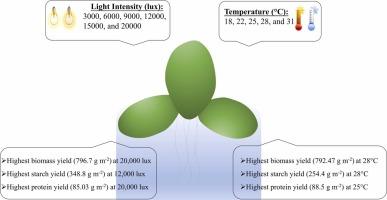提高光照强度和温度可促进浮萍生物量、蛋白质和淀粉的积累
IF 6.2
1区 农林科学
Q1 AGRICULTURAL ENGINEERING
引用次数: 0
摘要
浮萍生长迅速,淀粉积累高,对各种环境条件适应性强,是一种很有前途的可持续生物能源生产的非食物原料。光照和温度是影响浮萍生长和生物量积累的重要环境因子。本研究考察了不同光照强度(3000、6000、9000、12,000、15,000和20,000勒克斯)和温度(18°C、22°C、25°C、28°C和31°C)对Lemna trisulca的影响,重点研究了生物量、淀粉和蛋白质产量。结果表明,增加光照强度和温度可以促进浮子的生长和生物量产生,在20,000 lux(796.7 g m⁻²)和28°C(792.5 g m⁻²)时达到峰值。在最佳光照条件下(12,000 lux),淀粉产量达到348.8 g m - 2,淀粉含量达到干生物量的51.8 %,总生物量产量为724.7 g m - 2。蛋白质积累在15,000勒克斯和25°C(88.5 g m⁻²)时达到最大值。我们的研究结果独特地证明了优化光照强度和温度可以提高浮萍淀粉和蛋白质的积累,为工业化栽培提供了一个可扩展的框架。该研究为在不影响整体生长性能的情况下开发高效节能系统生产富含淀粉的L. trisulca生物量提供了实践见解。本文章由计算机程序翻译,如有差异,请以英文原文为准。

Elevated light intensity and temperature enhance biomass, protein, and starch accumulation in duckweed
Duckweeds represent a promising nonfood feedstock for sustainable bioenergy production, owing to their rapid growth, high starch accumulation, and adaptability to diverse environmental conditions. Light and temperature are significant environmental factors influencing the duckweed growth and biomass accumulation. This study investigates the effects of varying light intensities (3000, 6000, 9000, 12,000, 15,000, and 20,000 lux) and temperatures (18 °C, 22 °C, 25 °C, 28 °C, and 31°C) on Lemna trisulca, focusing on biomass, starch, and protein yield. The results showed that increasing light intensity and temperature enhanced the growth and biomass production of duckweed, peaking at 20,000 lux (796.7 g m⁻²) and 28°C (792.5 g m⁻²). Under an optimal light regime (12,000 lux), starch yield reached 348.8 g m−2, with starch content reaching 51.8 % of dry biomass and total biomass output of 724.7 g m⁻². Protein accumulation was maximized at 15,000 lux and 25°C (88.5 g m⁻²). Our findings uniquely demonstrate that optimizing light intensity and temperature enhances starch and protein accumulation in submerged duckweed, providing a scalable framework for industrial cultivation. This study offers practical insights for the development of energy-efficient systems to produce starch-rich biomass of L. trisulca without compromising overall growth performance.
求助全文
通过发布文献求助,成功后即可免费获取论文全文。
去求助
来源期刊

Industrial Crops and Products
农林科学-农业工程
CiteScore
9.50
自引率
8.50%
发文量
1518
审稿时长
43 days
期刊介绍:
Industrial Crops and Products is an International Journal publishing academic and industrial research on industrial (defined as non-food/non-feed) crops and products. Papers concern both crop-oriented and bio-based materials from crops-oriented research, and should be of interest to an international audience, hypothesis driven, and where comparisons are made statistics performed.
 求助内容:
求助内容: 应助结果提醒方式:
应助结果提醒方式:


